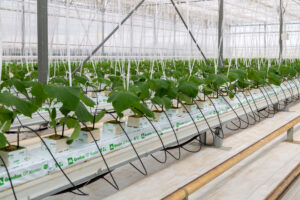Hydroponics is a term you might’ve heard of if you’re interested in agriculture, innovations, or both.
Nonetheless, regardless of where you first came across this concept, your reaction was probably a mix of curiosity and excitement.
Simply put, hydroponics is the art of gardening without soil. It requires a lot of careful planning and preparation, but the effects are well worth the effort. One could argue that it is among the most significant discoveries in urban innovation.
Since hydroponic cultures lead to the highest biomass and protein production compared to other growth substrates, these systems could revolutionize the way we approach agriculture. With their help, we can grow plants in harsh environments with little accessible water or underground.
Here’s an in-depth look into hydroponic systems and their numerous benefits:
What Is Hydroponics?
The word “hydroponics” is derived from two words: “hydro,” which means water, and the Greek word “ponos,” which translates to labor. In other words, it’s a method of growing plants using water instead of soil.
The absence of soil allows for better overall control over the plant’s environment as it makes it possible to regulate all the physical, chemical, and biological factors that promote growth.
But hydroponics is not without its own set of challenges; for instance, maintaining the proper pH level and nutrient balance is a constant battle.
Hydroponic systems can be either passive or active. The former relies on gravitational force to provide the necessary nutrients to the roots, while the latter uses pumps.
How Does Hydroponics Work?
Hydroponic systems work by suspending the plant’s roots in a solution of water and nutrients. The solution is then pumped through a system of tubing, where it flows back into the reservoir.
Because there is no soil, most of the nutrients plants need to grow are dissolved in water. This nutrient solution can be carried directly to the plant, or it can flow through a wick system. The nutrients then pass through the root system and into the plant, where the roots can absorb them.
Inoculants are often added as well, as these substances contain probiotics that enhance plants’ immune systems and disease resistance.
The most common type of hydroponic system is the nutrient film technique (NFT). In NFT systems, the roots are suspended in a shallow stream of water that contains all the essential nutrients.
What Are the Advantages of Hydroponics?
Hydroponics has many advantages over traditional farming methods. For one, it doesn’t require large tracts of land. You can set up a hydroponic farm in an urban environment with little space.
Hydroponic systems are also more efficient in terms of water and nutrient usage. Since the roots are constantly bathed in the nutrient solution, there is little to no wastage. Additionally, hydroponic farms use up to 90% less water than conventional farms.
Another advantage of hydroponics is that it allows you to control the environment in which the plants are grown. It means that you can optimize the conditions for maximum growth. For example, you can control the temperature, humidity, light, and CO2 levels.
Finally, hydroponic systems are not subject to seasonal changes. As a result, you can grow crops all year round, regardless of the weather outside.
What Are the Disadvantages of Hydroponics?
Despite all its advantages, hydroponics also has a few disadvantages.
Setting up a hydroponic system can be expensive. You will need to purchase pumps, tubing, reservoirs, and grow lights.
Besides, hydroponic systems require regular maintenance. The water and nutrient solutions need to be replaced every few weeks, and you must clean the system regularly to prevent the build-up of algae and bacteria.
Finally, hydroponic systems are vulnerable to power outages and equipment failures. If the pumps or lights fail, the plants will likely die.
How Can Hydroponic Systems Save the World?
In today’s world, we tend to take for granted how abundant resources truly are; we throw away food that goes bad in a couple of days, buy new items every time we need them, and throw away plastic bottles without a second thought.
Even though we are not necessarily aware of such wastefulness, it is still a part of our lives. It makes us feel like we have a limitless supply of anything, so there’s little to no reason to think about the future.
Unfortunately, this idea is false, and the truth is that we are running out of resources. The more of them we use up, the more it takes to replace what was once abundant in our world.
Hydroponics could help address this problem as it allows for growing plants anywhere with minimal water and soil. In doing so, it could solve the lack of food problems in certain parts of the world where growing crops is nearly impossible.
With hydroponic systems, we could produce food while in space as well. That way, we’d be able to expand our living spaces beyond the confines of our planet.
In the same vein as above, growing food with hydroponics requires significantly less water than traditional agriculture does. In fact, as mentioned above, it can decrease the amount of water used for irrigation by up to 90%.
Also, studies show that plants grown using hydroponic systems have higher nutritional value than those grown in soil. For instance, hydroponically grown tomatoes in a study from 2021 had higher lycopene and β-carotene contents than their soil-grown counterparts.
In Conclusion
As you can see, hydroponic systems are a great alternative to traditional agriculture. They allow us to grow plants in any environment, helping us overcome the challenges that await us in the future.
Still, there’s more to this approach than just growing fruits and vegetables in an unconventional way. It is also eco-friendly and sustainable, which are two critical factors we should keep in mind while growing our own food.
Overall, hydroponic systems are the future of agriculture. By quickly growing plants in harsh environments, these systems could bring an end to food shortages and hunger.
These systems are currently used in many urban gardens but also revolutionize food security in rural areas. As the world is becoming increasingly urbanized, hydroponics could become a crucial part of sustainable living.
Read more:
What Are Hydroponic Systems and How Can They Save the World?
























